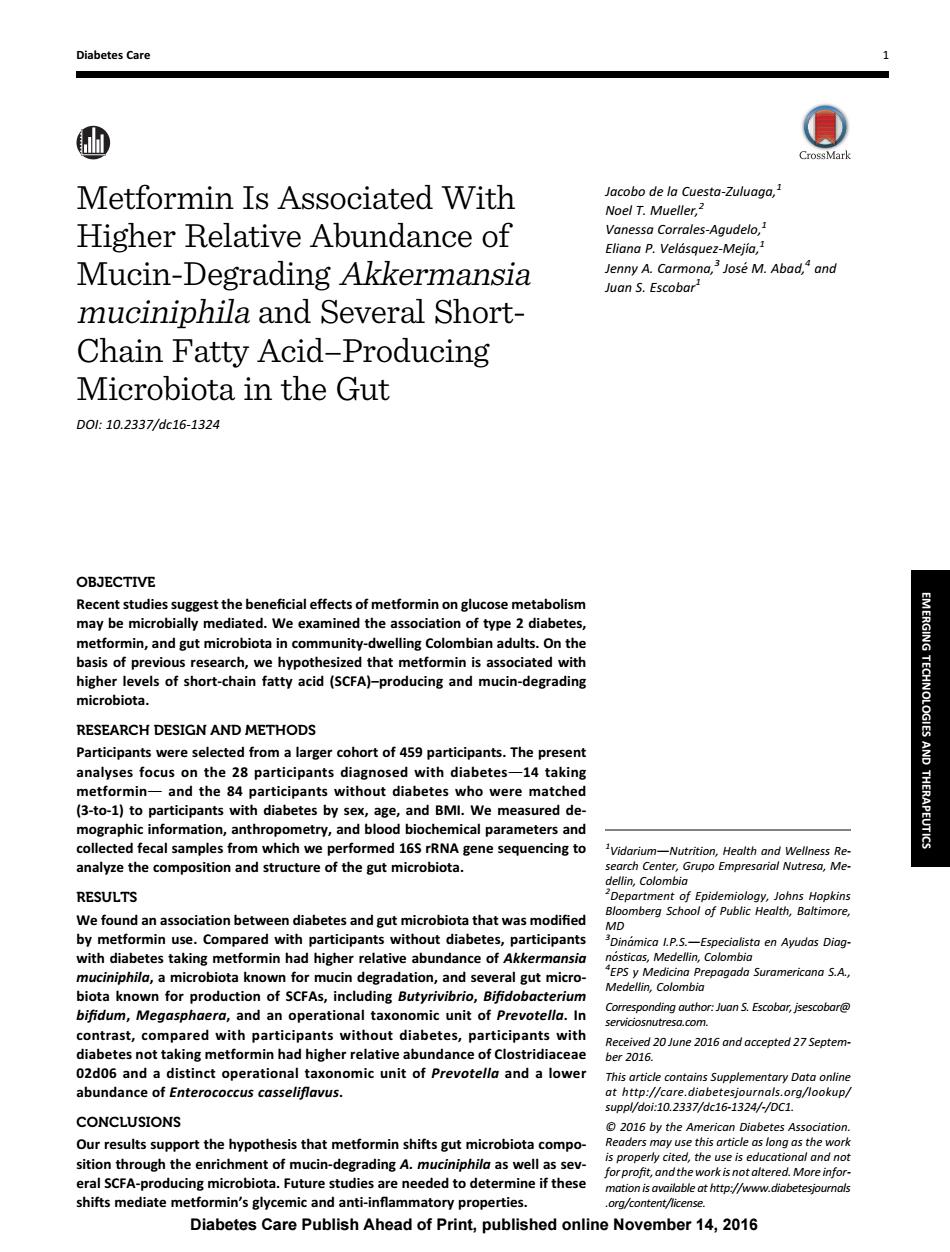正在加载图片...

DiabetesCare Metformin Is Associated With acobo de lo Cuesta-Zuluaga, Higher Relative abundance of tes-Agudelo, Eliang p velasquez-Meiig Mucin-Degrading akkermansia 从d muciniphila and Several Short- Chain Fatty Acid-Producing Microbiota in the Gut D0t:10.2337/dc16-1324 OBJECTIVE t the beneficial effects of metformin on glu memicroballymeddWemnd tection of type2dabetes metformin,and gut microbiota in community-dwelling Colombian adults.On the basis of previous research,we hypoth obiogaofshortehn sized that metformin is associated with fatty acid(SCFA)-producing and m cin-degrading RESEARCH DESIGN AND METHODS Participants were selected from a larger cohort of 459 participants.The present analyses focus on the 28 participants diagnosed with diabetes-14 taking metformin- and the 84 participants without diabetes (3-to-1)to P pants with di betes by s age.am We measured de analyze the composition and structure of the gut microbiota. RESULTS We found an association between diabetes and gut microbiota that was modified by metformin use nts with participants known for m rin de adation and s biota known for production of SCFAs,including Butyrivib Bifid acterium bifidum,Megasph and an ope rati n out diabetes pa 20 June 2016 and accepted 27 Septem 02dos and a distinct pperational taxonomis unit of Prevptell anda lowe r206 abundance of Enterococcus casseliflavus. CONCLUSIONS 2016 by the A Our results support the hypothesis that metformin shifts gut microbiota compo 北as ng as the wo n through the enr n-degrading A.n ld as w for profit.。 shifts mediate met min's glyc emic and anti-infammatory p le ot http://www. Diabetes Care Publish Ahead of Print,published online November 14,2016Metformin Is Associated With Higher Relative Abundance of Mucin-Degrading Akkermansia muciniphila and Several ShortChain Fatty Acid–Producing Microbiota in the Gut DOI: 10.2337/dc16-1324 OBJECTIVE Recent studies suggest the beneficial effects of metformin on glucose metabolism may be microbially mediated. We examined the association of type 2 diabetes, metformin, and gut microbiota in community-dwelling Colombian adults. On the basis of previous research, we hypothesized that metformin is associated with higher levels of short-chain fatty acid (SCFA)–producing and mucin-degrading microbiota. RESEARCH DESIGN AND METHODS Participants were selected from a larger cohort of 459 participants. The present analyses focus on the 28 participants diagnosed with diabetesd14 taking metformind and the 84 participants without diabetes who were matched (3-to-1) to participants with diabetes by sex, age, and BMI. We measured demographic information, anthropometry, and blood biochemical parameters and collected fecal samples from which we performed 16S rRNA gene sequencing to analyze the composition and structure of the gut microbiota. RESULTS We found an association between diabetes and gut microbiota that was modified by metformin use. Compared with participants without diabetes, participants with diabetes taking metformin had higher relative abundance of Akkermansia muciniphila, a microbiota known for mucin degradation, and several gut microbiota known for production of SCFAs, including Butyrivibrio, Bifidobacterium bifidum, Megasphaera, and an operational taxonomic unit of Prevotella. In contrast, compared with participants without diabetes, participants with diabetes not taking metformin had higher relative abundance of Clostridiaceae 02d06 and a distinct operational taxonomic unit of Prevotella and a lower abundance of Enterococcus casseliflavus. CONCLUSIONS Our results support the hypothesis that metformin shifts gut microbiota composition through the enrichment of mucin-degrading A. muciniphila as well as several SCFA-producing microbiota. Future studies are needed to determine if these shifts mediate metformin’s glycemic and anti-inflammatory properties. 1 VidariumdNutrition, Health and Wellness Research Center, Grupo Empresarial Nutresa, Medellin, Colombia 2 Department of Epidemiology, Johns Hopkins Bloomberg School of Public Health, Baltimore, MD 3 Dinamica I.P.S. ´ dEspecialista en Ayudas Diagnosticas, Medellin, Colombia ´ 4 EPS y Medicina Prepagada Suramericana S.A., Medellin, Colombia Corresponding author: Juan S. Escobar, jsescobar@ serviciosnutresa.com. Received 20 June 2016 and accepted 27 September 2016. This article contains Supplementary Data online at http://care.diabetesjournals.org/lookup/ suppl/doi:10.2337/dc16-1324/-/DC1. © 2016 by the American Diabetes Association. Readers may use this article as long as the work is properly cited, the use is educational and not for profit, and the work is not altered.More information is available at http://www.diabetesjournals .org/content/license. Jacobo de la Cuesta-Zuluaga,1 Noel T. Mueller,2 Vanessa Corrales-Agudelo,1 Eliana P. Velasquez-Mej ´ ´ıa,1 Jenny A. Carmona,3 Jose M. Abad, ´ 4 and Juan S. Escobar1 Diabetes Care 1 EMERGING TECHNOLOGIES AND THERAPEUTICS Diabetes Care Publish Ahead of Print, published online November 14, 2016